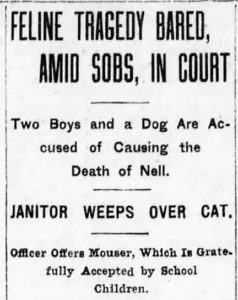
As I often explain, not all of the cat stories of Old New York that I share with my readers have fairy-tale endings. Of course I prefer to tell happy stories. But I also believe that the kitties that met tragic ends also deserve some attention. This story of Nellie, the classroom mouser of the Van Pelt Manor Grammar School in Brooklyn, is one such cat tale that I believe should have a tiny place in New York’s history.
A Brief History of Van Pelt Manor
From about 1890 until the early years of the 20th century, Van Pelt Manor was the name of a small neighborhood in Brooklyn of about 50 acres originally owned by the descendants of Teunis Jansen Lanen Van Pelt. Van Pelt had emigrated from Belgium in 1663 with his third wife and six children. The family settled in the colonial town of New Utrecht and eventually established a farm at what was then the town’s village hub.
Today this neighborhood is part of Bensonhurst, Brooklyn.
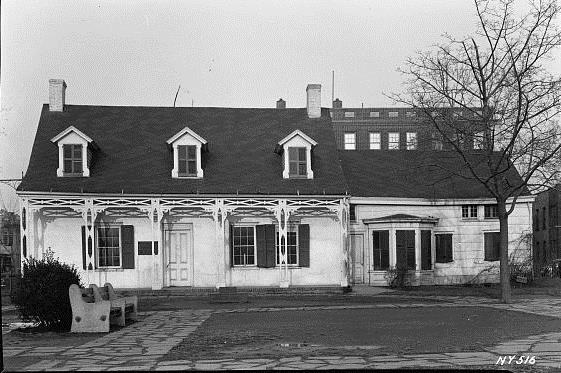
In 1890, John Lott Nostrand of New Utrecht purchased the Van Pelt farm and obtained permission from the family to cut up the land into small building lots. Working with his brother, George Engelbert Nostrand, he built a new neighborhood of single detached homes that he called Van Pelt Manor.


In 1897, an article in The New York Times described the new neighborhood of Van Pelt Manor as follows:
“Van Pelt Manor is the name of a growing settlement of cozy and picturesque cottages, on a large plot of land owned by J. Lott Nostrand. There are now twenty-five or thirty houses in Van Pelt Manor, which was started about five years ago, and plans have been prepared for several others. Van Pelt Manor is 6 miles from the Brooklyn City Hall, and can be reached by trolley cars from that point in about twenty-five minutes.”
Nellie, the Champion Mouser of Van Pelt Manor
Although Nellie made her home at the Van Pelt Manor Grammar School (aka Public School 128) on 83rd Street and 21st Avenue, the teachers and students called her “the most popular feline in Coney Island.” I don’t know how many years Nellie hunted the corridors of the new school building, but when the mouser met her tragic end courtesy of two mean-spirited boys and a St. Bernard dog, there was much sorrow throughout the school community.
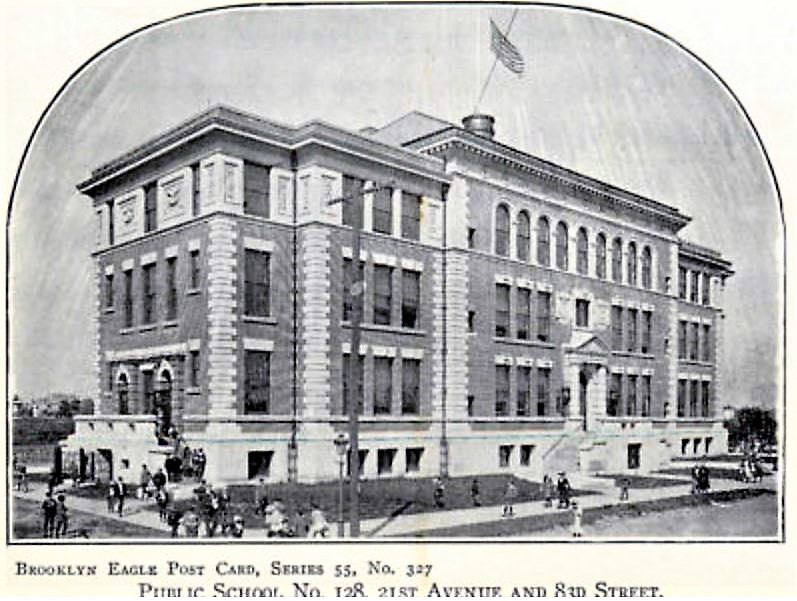
On the morning of November 23, 1910, two young boys, the school janitor, and several teachers appeared before Magistrate John E. Hylan at the Coney Island Magistrates Court. Flanked by an army of witnesses who all testified to “the exemplary conduct of the deceased during life,” the unnamed janitor told the magistrate how much he had loved the school cat.
Shedding briny tears “which pattered on the floor with a sound of rain on the roof,” and wiping his eyes with a red bandanna, the janitor told Magistrate Hylan that Nellie was “the finest cat that was ever foaled.” He added, “I mean that there never was such another cat, no never.”
There was reportedly not a dry eye in the room as witness after witness told the judge that Nell was a great mouser who had been very faithful to the school. They all said that everyone in the school felt a personal sorrow when the cat was killed.
“Nell would come so gently and quietly into the classroom, and no one would be aware of her presence until a little frantic squeak announced the death knell of a mouse,” one teacher said between sobs. According to the janitor and the teachers, the school had been infested with mice ever since all of the cat’s nine lives had ended. One teacher said she had to leap on her desk the day before in order to escape from a “marauding mouse.”
How Nellie Met Her Demise
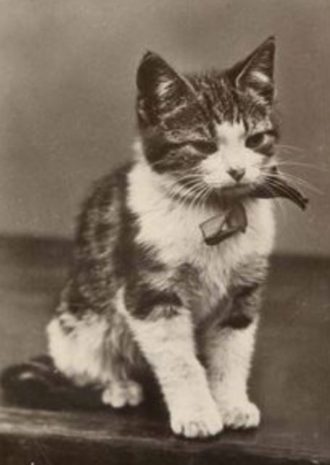
“Nellie was a lady. Last night she died. Toll the bell for lovely Nell, Coney Island’s pride.”--Brooklyn Daily Eagle, November 23, 1910
According to the testimony, Herman Miller and Mark Erdman, two young boys who resided in nearby Bath Beach, were responsible for Nellie’s death. One of the boys reportedly owned a large St. Bernard dog that had chased Nellie up a tree.
Not only did the boys encourage the dog to torment the cat, they also allegedly shook the tree, causing the cat to fall down and succumb to the deadly canine attack.
The judge asked the boys how close they were to the tree at the time of the incident. One boy said he was about 100 feet away, while the other boy said he was “as far as the Rocky Road to Dublin.” The boys insisted that the dog had gotten loose and killed the cat on is own accord without any assistance from them.
Magistrate Hylan dismissed both boys without charging them of a crime, but not after giving them a severe lecture.
Inspector Grace of the Brooklyn Society for the Prevention of Cruelty to Animals was reportedly so moved by the janitor’s testimony that he instantly offered to provide the school with a new cat. The inspector said he had a “slightly mildewed, show-worn cat” who was an excellent mouser that could easily conquer any rodent army. The janitor gratefully accepted the offer on behalf of the school.
The Original Schools of New Utrecht
Prior to 1890, when development began in earnest, New Utrecht was a large stretch of woodlands (about 8 square miles) with farms (or boweries) of various sizes scattered along roads at wide intervals (as seen in the 1852 map below.) Some of the larger farms of New Utrecht during the 19th century included those owned by the Van Pelt, Benson, Lefferts, Cowenhoven, Van Brunt, Wyckoff, Cropsey, and Suydam families.
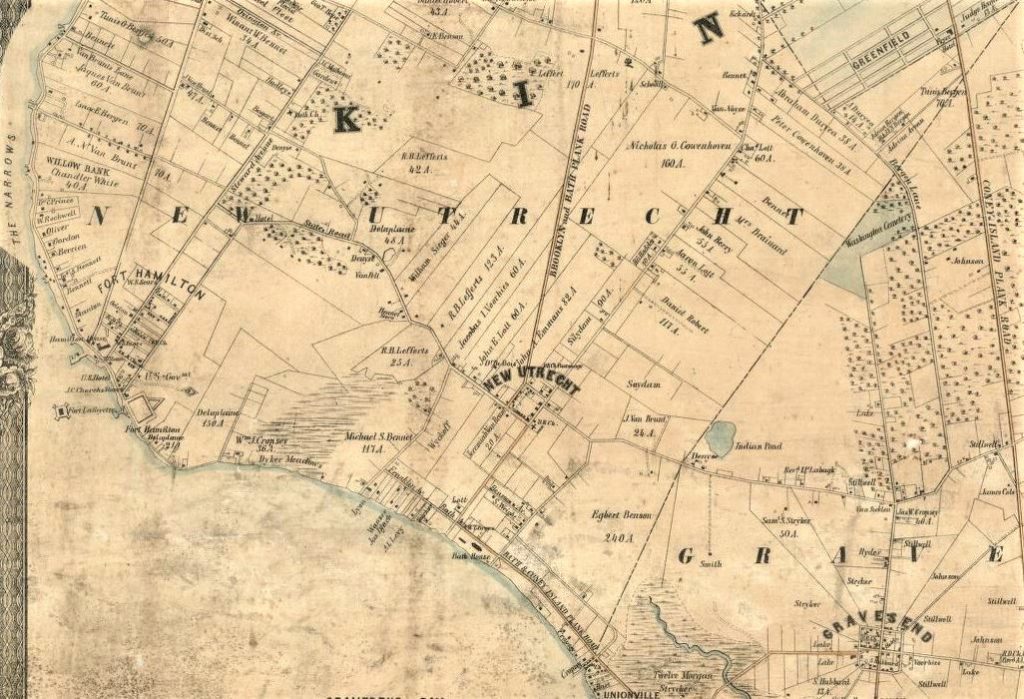
New Utrecht’s very first school was a “little red schoolhouse” that was established during the town’s colonial era, sometime after the British seized control of New Netherland from the Dutch in 1664.
Although there is some debate on the exact location of the school, several old published documents place it near the homes of Nicasius de Sille and John Lott Nostrand, both of which were near the old Dutch cemetery on Main Street (84th) and 16th Avenue. For example, in the Brooklyn Daily Eagle on August 4, 1913, it was reported that Nostrand’s “education was begun in the old red schoolhouse on Main Street, near his father’s farm…”
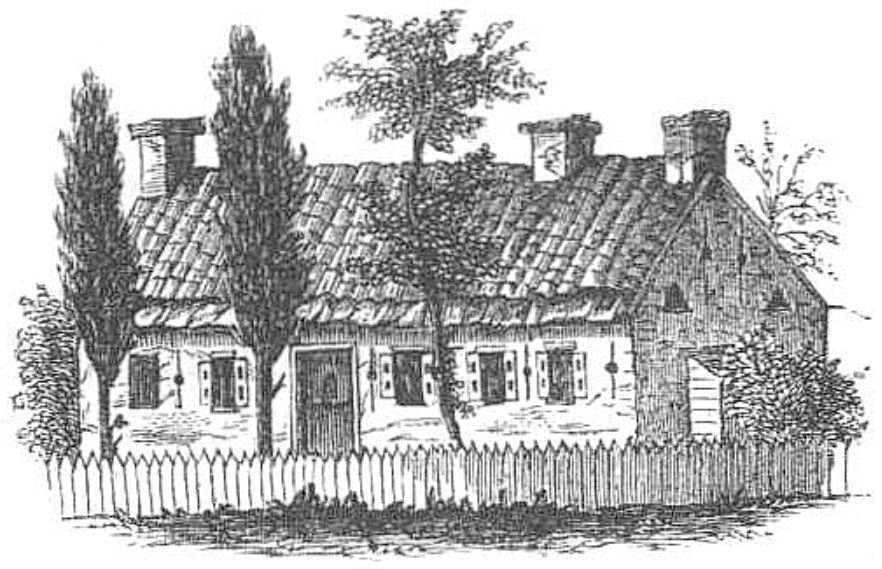
Records in the New York Public Library archives state that the New Utrecht Reformed Dutch Church was established in the schoolhouse in 1677, although services were often held in private homes for about 20 years. Because the school was so closely associated with the church, the school master was tasked with leading prayers and teaching catechism. (Up until 1785, only Dutch was spoken in the church and the school).
Eventually there was a semi-separation of church and state when a stone church was erected near the Dutch burial grounds in 1700, at what is now the northeast corner of 16th Avenue and 84th Street. This church stood next to the historical cemetery until 1828, when a new Reformed Church (extant) was constructed at the intersection of 18th Avenue and 84th Street (shown in the 1873 map below).

According to “Reminiscences of New Utrecht and Gowanus,” published by Mrs. Bleeker Bangs in 1912, George Washington came to visit the village school in 1790, and while he was there he patted young Peter Van Pelt on the head and told him to become a good man. Peter went on to become a minister in Staten Island. (Another Van Pelt child, John V., reportedly tried to burn the school down in order to have a vacation.)
Colonel William J. Cropsey, who attended the school in the 1830s, told Mrs. Bangs that the little schoolhouse had very hard wooden benches and only limited school supplies for the children who trekked two miles or more to the school from various locations throughout the large township.
New Utrecht Gets a Few New Schools
In 1795, New York lawmakers authorized a five-year grant to support elementary schools throughout the state. With these funds, a second school was erected approximately a mile and a half northeast of the village center, on New Utrecht Lane near present-day 53rd Street in Borough Park. (This school, called the Lane School, was later moved to 14th Avenue and 53rd Street in the 1890s).
At a special town meeting held in New Utrecht on August 12, 1813, three school districts were mapped out for New Utrecht. Residents of District One, which comprised the southeastern section of the town along Gravesend Bay, were served by the old village schoolhouse. The Lane School served District Three, and a new little yellow schoolhouse was constructed in 1823 for District Two on land owned by Albert Van Brunt, near present-day Ridge Boulevard and 72nd Street in Bay Ridge.
Incidentally, years after New Utrecht became part of the City of Brooklyn in 1894, the old schools of Districts One, Two, and Three were revamped and replaced by newer schools known as P.S. 101, P.S. 102, and P.S. 103.
The End of the Little Red Schoolhouse in District One
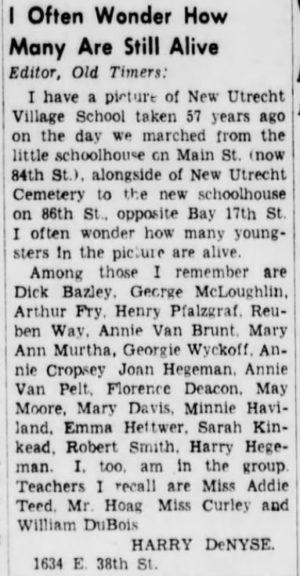
In 1872, the District One trustees purchased a lot adjoining the old Dutch cemetery on the south side of present-day 84th Street between 16th and 17th Avenues. The intention was to build an addition for the old village schoolhouse and enlarge the school yard. However, these plans never went through.
In 1883, the district selected a new site on 86th Street near 18th Avenue to erect a brand new school building for District One. This land was gifted to the trustees by Andrew Jackson Cropsey, who was then the largest property owner in New Utrecht.
To the left is a letter to the editor from an one old-timer who recalled the move to the new public school (Brooklyn Daily Eagle, 1940). The writer is no doubt a descendant of Denyse Denyse, who ran a ferry from New Utrecht to Staten Island in the 1700s.
The new Public School of District No. 1, which could accommodate up to 200 students, opened in May 1884. R.H. Brush was the school’s first principal.

In 1890, six years after the new public school opened, St. John’s Reformed German Evangelical Lutheran Church was established under the leadership of Reverend Theodore Duensing. For three years, the pastor conducted services in the Y.M.C.A. building next to the Reformed Dutch Church. Then in 1893, the German church’s new pastor, Reverend Lewis Happ, purchased the little red schoolhouse near the old cemetery.
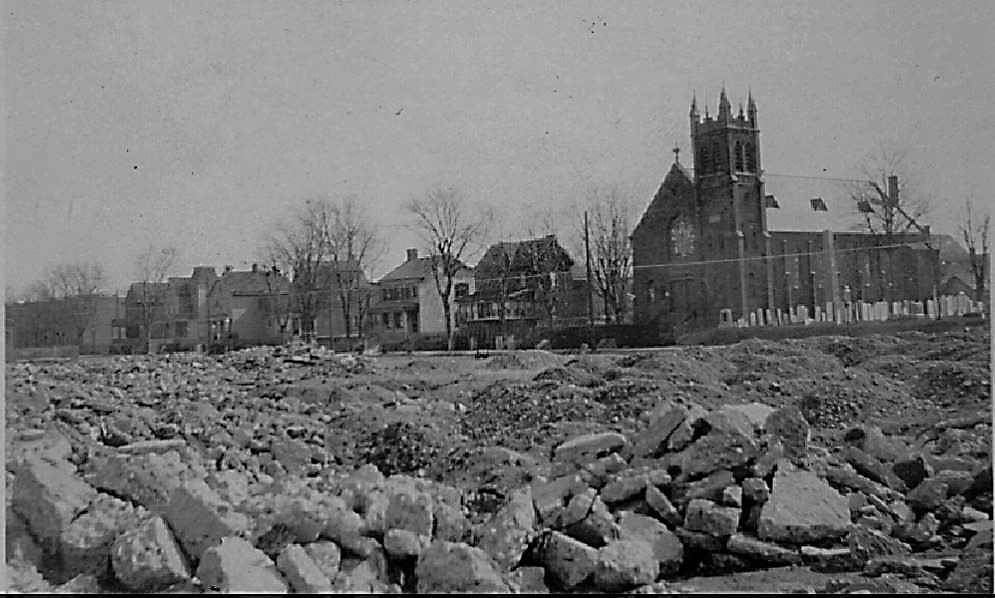

According to an article about St. John’s in the Brooklyn Daily Eagle on July 18, 1897, services were held in the schoolhouse until 1897, when it was sold and moved to an unknown location by the new owner. A new brick church was constructed on the site of the old school (today occupied by the Metropolitan Baptist Church).
Public School No. 128 (Van Pelt Grammar School)
As the population of Van Pelt Manor continued to grow, a new grammar school was needed to accommodate all the children. So in 1900, a contract was awarded to Rutan, Kenny, and Hemingham to construct a grammar school on the old Egbert Benson farm at 21st Avenue and 83rd Street. The total cost to construct the 20-classroom school was $120,000.
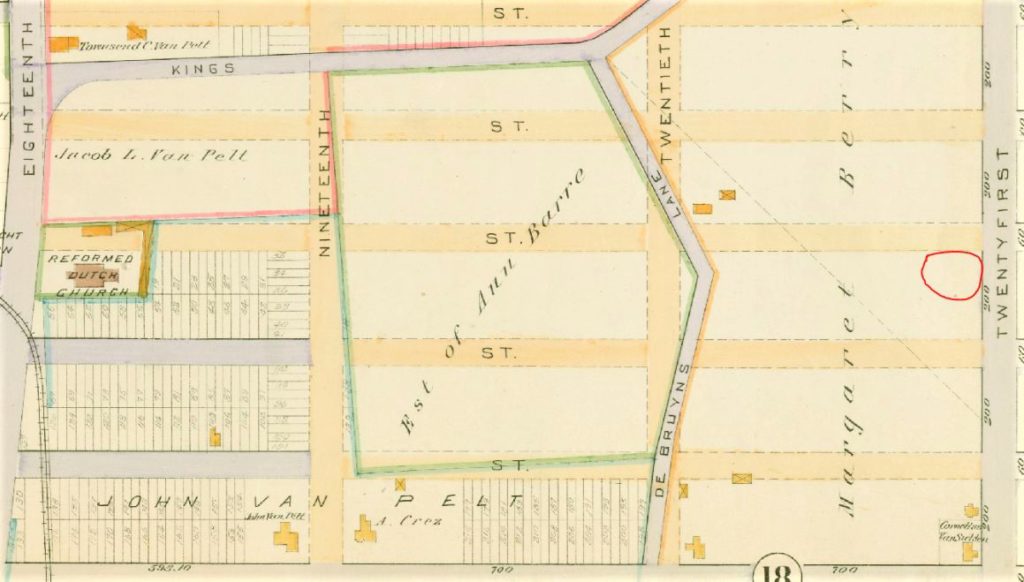
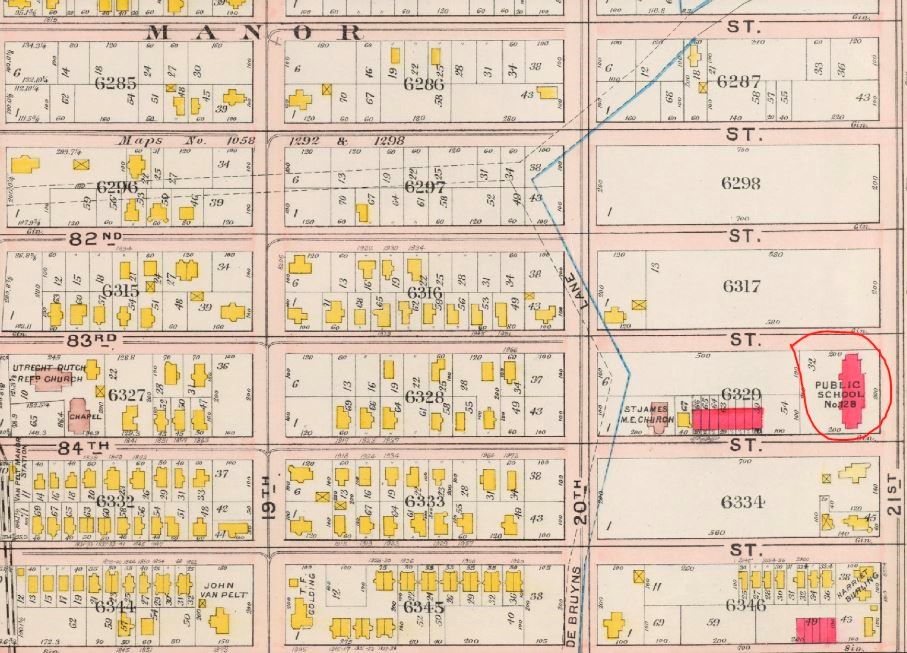
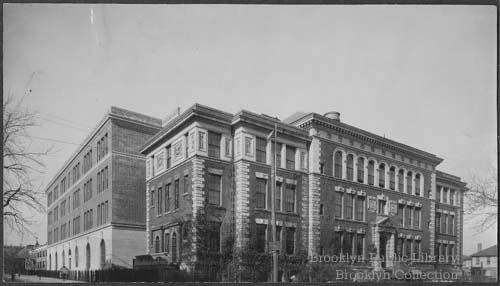
The new Public School No. 128 of Brooklyn–aka Van Pelt Manor Grammar School–opened in 1901. Thomas O. Baker was the first principal. Today, P.S. 128, now called the Bensonhurst School, is still an elementary school for children in Kindergarten through grade 5.



